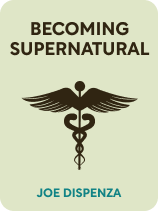

This article is an excerpt from the Shortform book guide to "Becoming Supernatural" by Joe Dispenza. Shortform has the world's best summaries and analyses of books you should be reading.
Like this article? Sign up for a free trial here.
What is Joe Dispenza’s Becoming Supernatural about? What is the key message to take away from the book?
In his book Becoming Supernatural, Joe Dispenza outlines a powerful plan for personal transformation. He says our subconscious mind is the most powerful aspect of our being, and we can use it to create the life we desire if we become aware of the power of our own thoughts.
Below is a brief overview of Becoming Supernatural by Joe Dispenza.
Becoming Supernatural
In his book Becoming Supernatural, Joe Dispenza explains how our thoughts and the resulting emotions create our reality and how we can use this knowledge to change our life to one of abundance and joy. He explains that this involves breaking free from old patterns of thinking by using meditation and visualization techniques to create a new reality and manifest your dreams.
He calls this “becoming supernatural” because you’re using the power of your thoughts alone to transform your physical reality. It’s a process of recognizing that you are more than your body and tapping into a power beyond what most people are able to access. This will make you appear to the average person to be achieving something supernatural.
Joe Dispenza is a chiropractor, author, and self-help speaker. His research interests include epigenetics, quantum physics, and neuroscience. Dispenza is also the author of Breaking The Habit of Being Yourself (2012) and You Are The Placebo (2014), both of which discuss the power of your mind for healing and changing your life. He is also featured in the 2004 documentary What The Bleep Do We Know!?.
This guide is organized into two parts. In Part 1 we’ll explain Dispenza’s premise that your experience of life is determined by deeply-embedded patterns of thought and emotion that can trap you in a vicious cycle of negativity. Then in Part 2, we’ll turn to an explanation of Dispenza’s methods for overcoming those patterns and creating a new reality for yourself.
Throughout the guide, we’ll compare some of Dispenza’s ideas to concepts and practices in long-established Buddhist and Hindu traditions, as well as their connection to the more historically recent New Thought movement.
Part 1: Your Thought-Feeling Patterns Create Your Life Experience
Dispenza begins by explaining that our whole experience of life is created by feedback loops between our thoughts and emotions—which we’ll call thought-feeling patterns. He says these thought-feeling patterns underlie all of your experiences and behaviors, so if you want to change your life, you must begin by changing your thoughts. This means you also need to get out of some of your habits and do things differently—which he describes as shifting to the “unknown.”
The thought-feeling pattern works like this:
- Your brain processes information and experiences in the form of thoughts which generate an electrical charge.
- That electrically-charged thought causes the brain to secrete chemicals.
- Those chemicals create the emotions you feel.
- The emotions become stored in your memories.
- Those emotionally-laden memories then affect how you’ll perceive, interpret, and respond to every subsequent experience you have.
- This means your thoughts will be influenced, and the cycle starts all over again.
So, Dispenza argues, when you experience something very negative or traumatic, as many people do, you can get stuck in a pattern where that memory and the bad feelings associated with it continue to influence your thoughts in the future. Your brain will interpret future information and experiences more negatively, resulting in further negative emotions, and so on in an endless loop. So to make your life better, you must learn to interrupt those negative thought-feeling patterns so you can begin to think and feel more positively.
Trauma Keeps You Stuck in the Past
Dispenza says that the stronger an emotion, the stronger the memory associated with it, and this explains why it’s so difficult to overcome thought and feeling patterns connected to trauma. Traumatic experiences evoke some of the strongest emotions we’ll ever feel, so they become deeply ingrained in our brains. This means trauma keeps us stuck in the past via our neural circuitry, causing us to get caught in vicious cycles of negative thought and emotion—we’re constantly perceiving the present in light of what happened to us in the past.
Dispenza also explains that our brains don’t necessarily distinguish between an actual experience and a memory of one—in other words, every time you remember an experience, your brain essentially re-lives it as if it were happening all over again. So, when you have a traumatizing experience, the memory of it can cause your autonomic nervous system to have a stress response, and when your body is frequently in this stress-response mode, it can wreak havoc on your health. So overcoming these deeply-ingrained thought-emotion patterns is crucial for both your mental and physical health.
One key to overcoming these trauma-induced stress responses is to recognize that your autonomic nervous system operates on a subconscious level. This means that any technique for interrupting and changing these patterns must act on a subconscious level as well. As we’ll see in Part 2, that’s what Dispenza’s meditation techniques are designed to do.
Shift From the Known to the Unknown
Because of this thought-feeling cycle that becomes ingrained in our memories and our neural circuitry, Dispenza says our brains are quite literally living in the past. Whether we have trauma or not, most of us are living in a state wherein our past constantly determines our present and our future. This means nothing in our life can change—the status quo is just reinforced day after day. He says in order to make any life change, we must shift from the known to the unknown, thereby allowing for new possibilities.
Think about your daily routines. It may go something like this: you wake up, have coffee, check your email and social media notifications, take a shower, get dressed, and head to work. At your job, you probably have a regular daily routine, and then you’ll go home and have your evening routine. Dispenza says that by doing things the same way every day, we train our brains to always expect the same things, so the same things will continue to happen.
For example, if you expect your commute to work to be stressful, you’ll create that stress by anticipating it. And your whole morning routine may be triggering that expectation in advance. By changing your morning routine, or taking a different route to work, you may be able to avoid some of that stressful experience by allowing for the possibility of something new. In other words, if you ever want something different to happen in your life, you’ll need to interrupt those habitual patterns so your brain can start expecting something new.
Dispenza emphasizes, however, that changing your external circumstances and daily routines is only one step in the process—a deeper internal shift also needs to happen to radically change your life. This is where meditation comes in.
Think Better Than You Feel to Improve Your Life
Because you can only ever create new possibilities for yourself when you are free from your familiar past and predictable future, Dispenza says you must learn to elevate your thought patterns—meaning, think more positive thoughts. This will then create more positive emotions, and eventually, a better future will follow.
Dispenza draws on concepts from the law of attraction to explain that a positive life change requires positive intentions. He says your intentions (thoughts) and emotions generate electrical and magnetic charges in your brain. The combination of these, then, becomes your electromagnetic field. In order to attract better things into your life, you must raise the vibration of your electromagnetic field. When you do this, experiences, situations, and people with a similar electromagnetic frequency will gravitate toward you.
Dispenza stresses that just having the intention is not enough. To turn the unknown (a possibility) into material reality requires intention and sincerely felt emotion. So, if you want to create positive change in your life, you need to generate emotional states that are greater than the ones you typically feel. And you need to maintain those elevated emotional states as much as possible as you go through life. This, of course, is easier said than done. Some techniques for how to do this will be discussed in Part 2.
Part 2: Meditation Creates New Thought-Feeling Patterns
Now that we know that our problems have negative thought-feeling patterns at their foundation, we need to understand what practical steps we can take to remedy these unhealthy feedback loops. Dispenza has developed specific meditation techniques designed to interrupt those cyclical patterns and generate higher-frequency and more harmonious mental activity.
In this second half of the guide, we’ll discuss some of Dispenza’s research into brain waves and look at how changing your brain waves taps into your subconscious programming. Then we’ll discuss why the heart is just as important as the brain, and how you can bring more energy into your heart center with breath work. Finally, we’ll look at a unique meditation method Dispenza has developed to prime your brain to expect a brighter future.
Changing Your Brain Waves Changes Your Mind
Dispenza’s research includes monitoring the brainwave states of his meditation practitioners. In the book, he shares images from brain scans of his students to illustrate how dramatic the changes can be. He says that changing your life will mean changing your brain waves so that you have access to your subconscious mind.
Dispenza explains that brainwave frequencies include the following:
- Beta waves: In your regular, waking consciousness your brain tends to be in a beta wave state most of the time. This can include:
- Low-range beta waves: when you’re relaxed and not perceiving any threat in your environment, but you’re still alert—for example, when you’re chatting with a friend or playing with your child.
- Mid-range beta waves: a more alert state when you’re slightly aroused but not terribly stressed—for example, when you’re driving in an unfamiliar city or doing a presentation at work.
- High-range beta waves: when you’re in a high-stress state, such as road rage or in fear because you feel threatened.
- Alpha waves: Your brain is in an alpha wave state when you’re very relaxed, calm, and creative. You may slip into alpha-wave states throughout your day if you engage in meditative or creative practices that allow you to get out of your thoughts and into a calm “flow” state.
- Theta waves: your brain slips into a theta-wave state when you’re in that zone between waking and sleep—or when you’re in deep meditation.
- Delta waves: This is the brainwave state you’re in when you’re asleep, but very adept meditation practitioners can also go into delta-wave states while awake.
- Gamma waves: Dispenza calls this brainwave state a “superconscious” state. It’s a state associated with intense focus and transcendental and mystical experiences.
Dispenza explains that to tap into your subconscious mind, you must train your brain through meditative practices to drop into the lower-frequency brainwave states. This is because those are the states in which you access your deepest subconscious programming. He says when your brain waves change from beta to alpha, theta, and delta, your autonomic nervous system reacts differently to the world. Rather than responding to the world with stress and fear, it responds in a healthy way, which will keep you from responding to life through the lens of the past.
Additionally, Dispenza says that meditation improves the coherence of your brain waves, meaning they go from being disorganized and inconsistent to moving in a more smooth and harmonious pattern.
Meditation for Changing Your Brain Waves
To change your brain waves, Dispenza suggests a meditation that has you focus your attention on the various parts of your body, one at a time. Even more importantly, though, he says as you focus on each body part, you should also try to become aware of the space that surrounds those body parts. As your attention moves throughout your body, and to the space around it, you then start to become more aware of all the space surrounding you—from the space directly around your body, to the space of the whole room, and outward to the whole universe. This puts you in a mindset where you become aware of yourself as a part of the whole, and it will shift your brain waves from beta to alpha and theta-wave patterns. Dispenza offers the more detailed guided meditation on his website.
By practicing this meditation regularly, Dispenza says you’ll begin to feel all the potential that exists in the universe, and your energy becomes aligned with the universal energy. This means you’re tapping into and attracting that vast energetic potential in the universe, and you’ll begin to attract everything you desire.
The Heart Is Just as Important as the Brain
In addition to the brain, Dispenza says the heart is an essential piece of the puzzle because your heart is in constant communication with your brain and central nervous system. This means that, like your brain, your heart is also a source of knowledge and emotion, so it’s important that it’s in a coherent state.
Like our brain waves, our heartbeat can also be either inconsistent or coherent, Dispenza explains. A coherent heartbeat is more conducive to peaceful and positive emotions and raises your electromagnetic vibration. So your negative thought-feeling patterns are reflected in your heart as well. This means it’s important to activate your “heart center,” which means resting your attention on your heart in meditation in order to bring positive energy to it.
Dispenza illustrates the importance of the heart by describing some case studies of heart transplant patients who experienced subtle changes in their personalities after receiving a transplant. In one case, a woman who received a heart transplant from a young man developed cravings for specific foods that she had never craved before, and she later found out they were the favorite foods of the heart donor. According to Dispenza, this means there is knowledge stored in our hearts as well as our brains.
Meditation for Heart Wisdom
To increase the energy in your heart center, Dispenza offers a meditation involving bringing your awareness to your heart as you breathe and set intentions. In this meditation, you’ll pay attention to your chest as it expands and contracts each time you take a breath. As you breathe like this, concentrating on your heart center, you’ll think about a positive intention for your life and try to generate a corresponding heartfelt positive emotion. (Shortform note: Dispenza’s website doesn’t include a guided version of this meditation, but you can find a version of it on the Insight Timer app.)
This exercise can be done for 10 minutes at first, and you can increase the time as you feel comfortable with it. Dispenza says this will create a more calm and coherent heart rate, relieving stress and anxiety, and conditioning your body and mind to feel love and compassion instead of fear and anxiety.
Understanding Your Energy Centers
A third component to transforming your thought-feeling patterns is what Dispenza calls the body’s “energy centers.” These are what is known in yogic philosophy as “chakras.” He says the body stores emotions in the form of energy in the chakras, and the way that energy is stored, and in which chakras, will affect your physical and mental health. He provides a breathing technique designed to move your energy through the chakras, clearing away the negativity and increasing the flow of positive energy. Let’s look at how this works.
There are seven major chakras in the body, in a straight line from the base of your spine to the crown of your head:
- The lowest three chakras, which are located in the lower half of your torso, are associated with survival—they contain energy related to sexuality and reproduction, digestion and elimination, and competition for survival. Emotions like anger, frustration, and guilt tend to get stored in these lower centers, particularly the third center, known as the “solar plexus.” This is why you often feel these emotions in your gut.
- The fourth chakra is located in the middle of your chest and is associated with your heart. This center generates the energy of love, compassion, and selflessness.
- The fifth chakra is located in the area of your throat and is associated with empowerment through language and expressions of truth.
- The sixth chakra is located in the middle of your head, behind the space between your eyebrows, and is sometimes called your “third eye.” This center is associated with higher states of consciousness.
- The seventh chakra is located at the top of your head and is associated with experiences of the divine or supernatural.
Dispenza says most people tend to hold the majority of their energy in the lower three chakras, and this keeps us mentally in survival mode. This means we go through life acting more on our instinctual drives than on our higher abilities. He explains that energy moves through your spinal cord via what he calls a “prana tube” and the goal of meditation is to move that energy from the lower chakras to the higher ones. Increasing energy in the higher chakras will shift your perspective from one of ego and survival to one of selflessness and connectedness. And he says breathwork can help you raise that energy, thereby increasing the power of your electromagnetic field and generating elevated emotions.

———End of Preview———
Like what you just read? Read the rest of the world's best book summary and analysis of Joe Dispenza's "Becoming Supernatural" at Shortform.
Here's what you'll find in our full Becoming Supernatural summary:
- How to use the power of your thoughts to transform your physical reality
- Why you may be trapped in a vicious cycle of negativity
- A unique meditation method you can use to reprogram your subconscious






